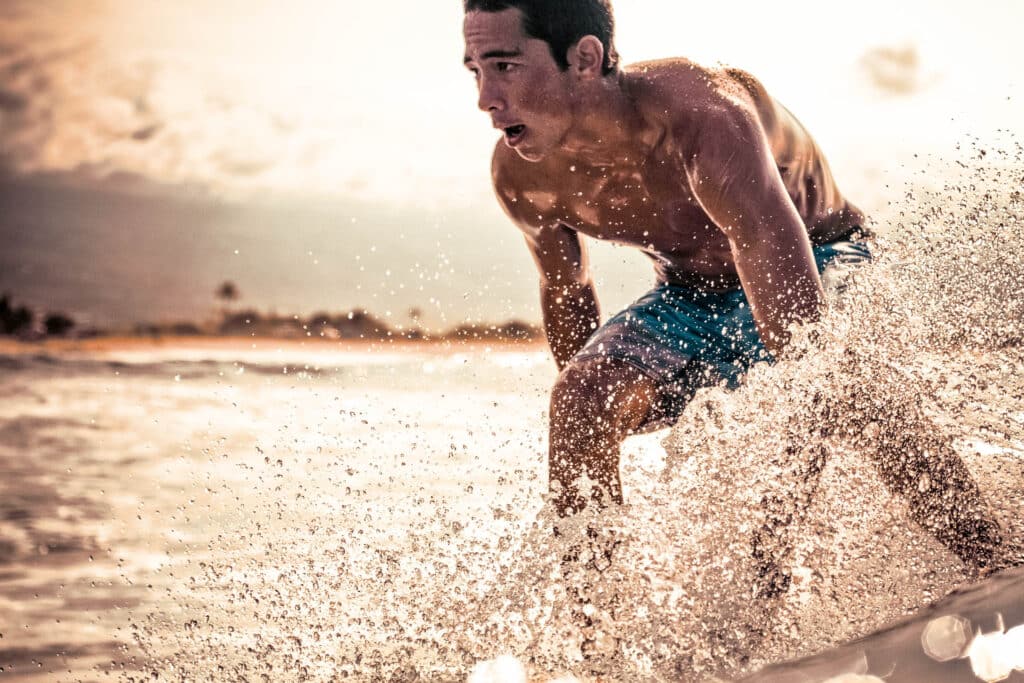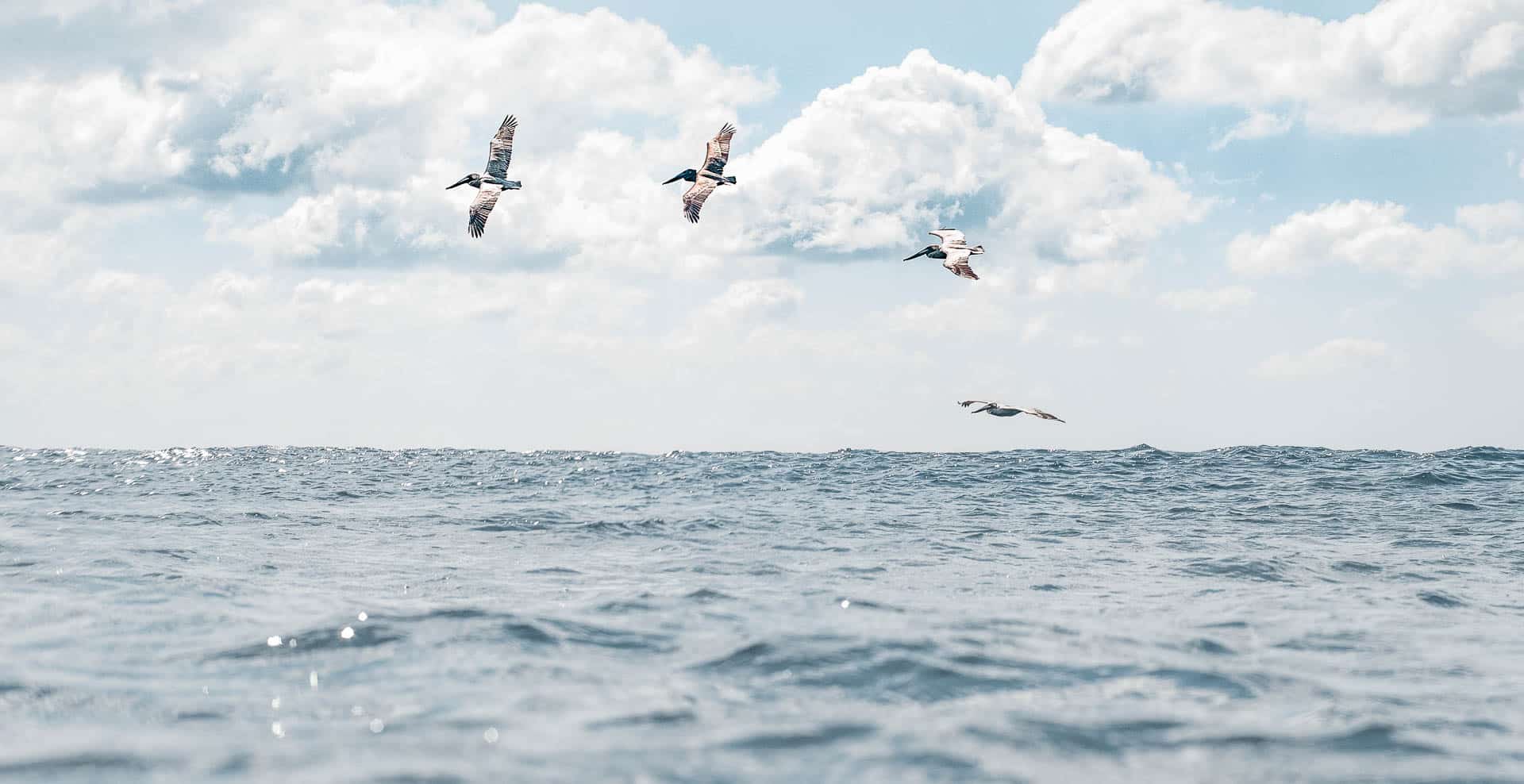Surfing is a dynamic and exhilarating sport that holds endless possibilities for improvement and growth.
In your transition from beginner to intermediate, you’ve learned to catch waves and navigate the white water with increasing finesse. Now, as you set your sights on the next echelon of surfing expertise, it’s crucial to pay attention to a few key aspects.
Delving into the world of catching waves, enhancing your pop-up technique, and building a more profound understanding of your chosen surf spots will undoubtedly enhance your experience. Through our curated tips, you can pave the way for their own surfing revolution. So, embrace these tips, embark on new adventures, and let the waves guide you toward your aspirations.
1. Catch Waves
Understanding the ocean’s waves is a crucial aspect of successful surfing. Begin by observing the patterns of the waves, including how they break and the direction they move.
Focus on catching white water waves, which are the waves that have already broken. These waves provide a gentler entry point for beginners. As you gain experience and confidence, you can progress to catching waves, known as green waves. Reading waves involves observing the swell, identifying the optimal point to paddle, and timing your pop-up for a smooth ride.
2. Refine Your Pop-Up Technique
By now, you’re likely familiar with the pop-up—a fundamental move in surfing that transitions you from paddling to riding the wave. As an intermediate surfer, focus on refining your pop-up technique to make it faster, smoother, and more fluid.

Practice the pop-up on the beach using proper form, ensuring that you’re landing in a balanced stance with your feet shoulder-width apart and facing the nose of the board. A quick and confident pop-up allows you to catch waves earlier and with greater ease.
3. Unbroken Waves
The transition from catching white water waves to unbroken waves—an exciting milestone for intermediate surfers. Choose a beginner-friendly surf spot with gentle and consistent waves to practice catching green waves.
As the wave approaches, use your paddling skills to match its speed and timing. Once you feel the wave’s energy lifting your board, execute a smooth pop-up to start riding down the line.
Catching unbroken waves provides a longer and more exhilarating ride, allowing you to fully experience the thrill of riding the open face of the wave.
4. Expand your knowledge of the ocean
Intermediate surfers can greatly benefit from deepening their understanding of ocean dynamics. Learn to read the surf forecast, which provides valuable information about wave height, direction, and period.
Familiarize yourself with surf conditions, tide charts, and wind patterns to choose the best time to hit the water. Knowledge of local surf breaks, point breaks, and reef breaks can help you anticipate wave behavior and choose the most suitable spot for your skill level.

5. Progress to a smaller board
As your surfing skills advance, consider transitioning to a smaller board. A smaller board offers greater maneuverability and responsiveness, allowing you to perform more dynamic turns and maneuvers.
However, make the transition gradually—opt for a board that’s slightly smaller than your current one and progressively work your way down in size. This step ensures a smooth learning process and prevents frustration.
6. Perfect the Duck Dive and Turtle Roll
Navigating through breaking waves is an essential skill for intermediate surfers. Learn the techniques of both the duck dive and the turtle roll to efficiently get through waves without being pushed back.
The duck dive is suitable for shortboards, where you push the nose of the board underwater while maintaining balance. For larger boards, such as longboards or beginner-friendly boards, the turtle roll involves flipping the board upside down and holding onto the rails.
Mastering these techniques improves your wave-catching efficiency and keeps you in control.

7. Practice Bottom Turns
For beginner surfers, especially those in the early stages of learning to surf, mastering the technique of executing smooth and controlled bottom turns is a fundamental aspect that can significantly enhance their surfing experience. Starting with beginner-friendly spots and taking surf lessons can lay the foundation for a successful journey into the world of surfing. Beginners often find themselves catching waves on foam boards or larger beginner surfboards, which provide stability and buoyancy for those initial attempts.
As you progress through surf lessons and gain confidence, the importance of bottom turns becomes evident. These turns involve shifting your weight and engaging your back foot to smoothly pivot your board, allowing you to set up for more advanced maneuvers and navigate the wave face with finesse.
This skill opens up a whole new realm of possibilities as you venture into more challenging surf spots and encounter bigger, breaking waves.
8. Experiment with Foot Placement
For beginner surfers who are venturing into the exciting world of wave riding, one of the essential aspects of skill development is experimenting with foot placement on the surfboard.
As you embark on your journey of learning to surf, paying attention to foot positioning can significantly impact your ability to catch waves, maintain balance, and ride with more control and finesse.
This is especially important as you progress from catching whitewater waves to the exhilarating challenge of catching unbroken green waves.
Experimenting with the placement of your feet along the length of the board can help you find the sweet spot that offers the best balance and control.

9. Surf Both Frontside and Backside
For beginner surfers, it’s essential to embrace the challenge of surfing both frontside and backside. Learning to ride waves from both directions not only adds to your skillset but also enhances your overall surfing experience.
Make it a point to practice catching waves both frontside and backside. This well-rounded approach allows you to develop a more versatile style and adapt to various wave conditions.
Remember, catching waves is about timing, positioning, and balance, whether you’re facing the wave (frontside) or your back is to it (backside). While frontside riding is often considered more intuitive for beginners, mastering backside surfing adds depth to your repertoire.
10. Explore More Surf Spots
While you may have found your favorite surf spots, don’t be afraid to explore new areas. Venturing to different surf spots exposes you to a variety of wave types and conditions, enhancing your adaptability as a surfer.
Consider taking a surf trip to our Milfontes location – known for its consistent and varied waves. Exploring different spots challenges your skills, exposes you to new challenges and accelerates your progress.
11. Build Your Surf Fitness
As you progress as an intermediate surfer, focus on building your surf-specific fitness. Engage in exercises that improve your paddling strength, core stability, and flexibility.
Yoga, swimming, and functional fitness workouts can enhance your endurance and overall physical preparedness for long sessions in the water. A strong body translates to better wave-catching ability and improved manoeuvre execution.

12. Surf Lessons – Film and Analyze Your Sessions
Recording your surf sessions allows you to objectively analyze your techniques and identify areas for improvement. Set up a camera on the beach or attach it to your board to capture your rides.
After your session, review the footage to assess your pop-up, positioning, wave selection, and turns. This self-analysis helps you understand your strengths and weaknesses and provides valuable insights for refining your skills.
13. Seek Guidance from Experienced Surfers
Connecting with more experienced surfers can provide valuable insights and advice. Strike up conversations with local surfers or seek mentorship from advanced surfers who are willing to share their knowledge.
Learning from their experiences can help you navigate challenging conditions, improve your wave count, and refine your technique.
14. Embrace a Growth Mindset
As an intermediate surfer, maintaining a growth mindset is essential for continuous improvement. Embrace the learning process, and understand that setbacks are opportunities for growth.
Celebrate your progress and successes, and remain open to trying new approaches and techniques. Keep the love for surfing alive by staying curious, humble, and dedicated to refining your skills.
As you’re learning the ropes of surfing, remember these valuable beginner surfing tips: don’t be afraid to catch waves at beginner-friendly spots during a surf trip. These spots often offer softer waves and a less crowded environment, allowing you to focus on your skills without the pressure of more advanced surfers or crowded lineups.
Incorporating yoga exercises, such as those done on a yoga mat, can aid in improving flexibility and balance, contributing to a more fluid and coordinated motion while executing bottom turns. Additionally, practicing duck diving and learning the art of efficiently navigating through breaking waves is essential, especially for those looking to explore more advanced spots.
Learning to read surf forecasts, understanding wave patterns, and familiarizing yourself with surf etiquette are essential components of becoming a great surfer. Moreover, consider watching surf movies and observing other surfers to gain insights into techniques and styles.
By following these surfing tips, you can enhance your skills, expand your ocean knowledge, and elevate your overall surfing experience. Remember, surfing is not just about riding waves—it’s a lifelong journey of learning, growing, and embracing the beauty of the ocean.
Embark on an unforgettable surfing journey with Rapture Surfcamps, your premier surf school in Bali! Join us to catch the waves, refine your skills, and experience the thrill of surfing in one of the world’s most stunning locations. Dive into the ultimate surf adventure with Rapture Surfcamps – where passion meets the perfect wave. Book your spot now and ride the waves with the best surf school in Bali!
FAQs
Start with the basics. Learn proper paddling techniques and how to pop up on the board. Mastering these fundamentals will significantly improve your surfing experience.
Beginners usually start with a longboard because of its stability and ease of paddling. As you progress, you can explore different board sizes and shapes based on your preferences and skill level.
Reading waves is crucial. Understanding wave patterns helps you position yourself correctly, catch waves efficiently, and enhance your overall surfing skills. Take time to observe the ocean and its movements.
Absolutely. Always wear a leash to keep your board attached to you. Be aware of your surroundings, including other surfers, and follow proper etiquette in the lineup. Know your limits and avoid surfing in conditions beyond your skill level.
Paddling is a key component of surfing. Practice swimming and incorporate paddle drills into your routine. Strengthening your shoulders and back will enhance your paddling endurance.
Consistency is key. Surf regularly to build muscle memory and improve your balance. Consider taking lessons from experienced instructors to receive personalized guidance and tips.
The right wetsuit depends on the water temperature. In colder conditions, opt for a thicker wetsuit. Make sure it fits snugly to provide insulation without restricting movement.
Respect other surfers by following established rules, such as not dropping in on someone else’s wave, waiting your turn in the line-up, and avoiding snake-like behaviour. Good etiquette creates a positive surf environment.
Yes, vary your surfing experiences. Practice in different wave sizes and conditions to enhance your adaptability and confidence. It also helps you become a more well-rounded surfer.
Rinse your board with freshwater after each session to remove salt and sand. Store it properly, avoiding direct sunlight and extreme temperatures. Regularly check for dings and repair them promptly to maintain your board’s performance. Remember, surfing is a continual learning process, and each session provides an opportunity to refine your skills. Stay patient, enjoy the process, and always prioritize safety.


